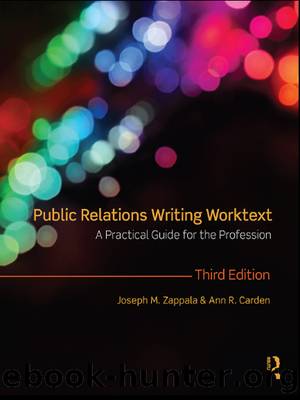Public Relations Writing Worktext by Zappala Joseph M.;Carden Ann R.;

Author:Zappala, Joseph M.;Carden, Ann R.;
Language: eng
Format: epub
Publisher: Taylor & Francis Group
Published: 2011-02-01T00:00:00+00:00
a wire story on the food page of a daily newspaper about the entertaining chef of three food and cooking programs on a cable network;
an article about the launch of the âfirst of a new generationâ of video game systems in the science and technology section of a major news magazine;
an interview on a national morning talk show with an author whose current book focuses on the need for better educated teachers in our schools.
In each of these cases, itâs likely that the organizations and individuals involved pitched their stories. Each has a specific, âbottom-lineâ goal in trying to cultivate media interest. The cable network is trying to promote its food programs and boost viewership. The video company is looking to build consumer interest in its product and strengthen its reputation as a leader and innovator in that industry. The author is hoping to position himself as an expert on education and to stimulate book sales. But the media have no interest in what the organizations want; their goal is to provide news and information that will be of interest to readers and viewers.
In the case of the video game story, then, the astute public relations professional recommends an angle focusing on the impact this new video game will have on consumers and how it will revolutionize the industry. The company gets exposure indirectly by being identified as the productâs manufacturer and through quotes from corporate marketing and product development executives. Emphasis is on the consumer product and the issues and trends surrounding it, not on the company and how wonderful it is for introducing this product.
Thatâs the key to successful media pitching. You need to put your own interests aside, and concentrate on finding a news âhookâ or angle that appeals to the media. Many times, that involves making your company and its product part of a âbigger-picture story.â In the case of the video game company, that âbigger pictureâ is the growth of the video game industry and notable trends in video game technology. The company is really secondary to the story. Timeliness also strengthens your pitch. The talk show interview on teaching standards took place days before the start of a new school year, and the video story ran one week before the product hit the market. The media pitch in Exhibit 7.5 does a nice job of establishing a timely news hook.
The best results come from individualized pitches. Target a specific idea to a specific editor or reporter at a specific publication. The media like exclusivityâgetting a story idea that no other publication is getting at that time and being the first to publish such a story. Consider your goals and target audience first and select a publication that greatly influences or is widely read by that group. Before making the media pitch, read the publication and become familiar with the types of story it likes to publish, preferred story angles, and the most appropriate editor or section to pitch. Such preparation will make your pitch stand out.
Download
This site does not store any files on its server. We only index and link to content provided by other sites. Please contact the content providers to delete copyright contents if any and email us, we'll remove relevant links or contents immediately.
Influence: The Psychology of Persuasion by Robert B. Cialdini(4598)
The Miracle Morning by Hal Elrod(4420)
The Hacking of the American Mind by Robert H. Lustig(4080)
Pre-Suasion: A Revolutionary Way to Influence and Persuade by Robert Cialdini(3970)
Unlabel: Selling You Without Selling Out by Marc Ecko(3463)
Ogilvy on Advertising by David Ogilvy(3324)
Hidden Persuasion: 33 psychological influence techniques in advertising by Marc Andrews & Matthijs van Leeuwen & Rick van Baaren(3290)
Purple Cow by Seth Godin(3067)
Who Can You Trust? by Rachel Botsman(3024)
Kick Ass in College: Highest Rated "How to Study in College" Book | 77 Ninja Study Skills Tips and Career Strategies | Motivational for College Students: A Guerrilla Guide to College Success by Fox Gunnar(2990)
This Is Marketing by Seth Godin(2901)
I Live in the Future & Here's How It Works by Nick Bilton(2839)
The Marketing Plan Handbook: Develop Big-Picture Marketing Plans for Pennies on the Dollar by Robert W. Bly(2791)
The Power of Broke by Daymond John(2767)
Building a StoryBrand by Donald Miller(2751)
The 46 Rules of Genius: An Innovator's Guide to Creativity (Voices That Matter) by Marty Neumeier(2675)
Draw to Win: A Crash Course on How to Lead, Sell, and Innovate With Your Visual Mind by Dan Roam(2639)
The Tipping Point by Malcolm Gladwell(2552)
Market Wizards by Jack D. Schwager(2538)
